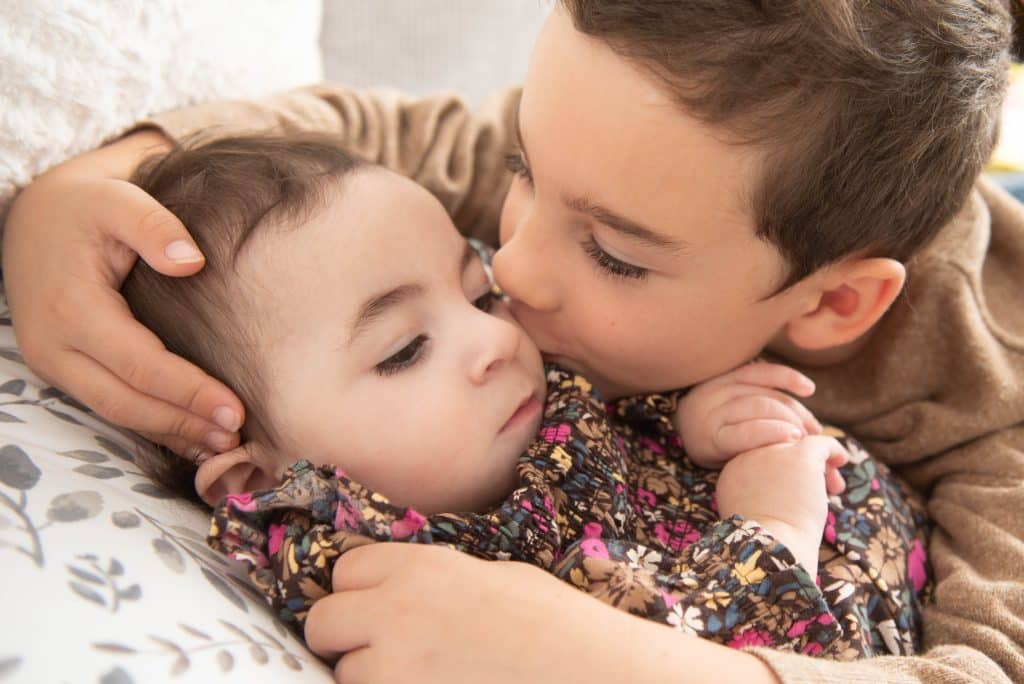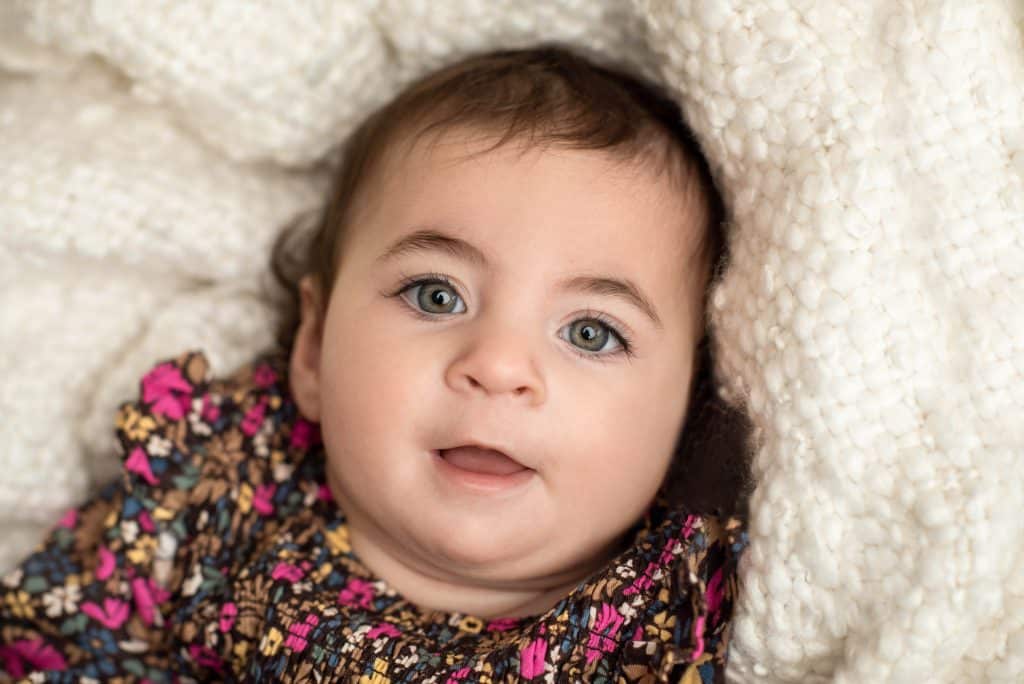We are proud to say that these posts are not sponsored. Our editorial team of Bobbie moms and writers personally select each featured product. If you buy something through our links, we may earn an affiliate commission, at no cost to you.
This is a story about finding courage and hope after a new and devastating diagnosis. It’s also a story about dragons. In Emily Rapp Black’s memoir about losing her son to Tay Sachs disease, The Still Point of the Turning World, she describes parents of terminally ill children as Dragon Parents. Like medieval mapmakers inscribing unknown regions of the world with the phrase “Here Be Dragons,” we represent most people’s worst fear and something nobody wants to acknowledge: the anticipatory grief of a parent who has received a death sentence for their child.
Dragons, because we would walk through fire and take a sword through the chest to take away our children’s pain.
When I was pregnant with my second child, my main concern was how I was going to keep the “big kid” legos my son scatters around the house like confetti out of the curious fists of his little sister. I wasn’t worried about her ability to meet milestones like crawling and developing fine motor skills like a pincer grasp. My pregnancy was healthy and typical, and together, baby girl and I passed every test and scan with flying colors. Like most rare disease parents, I was utterly clueless about what was to come.
Getting induced for baby #2
I went into labor the night before my induction. My induction went smoothly and a few hours later the nurse who checked on me said she could feel my daughter’s ear! After pushing for all of five minutes, Violet was born, and I was over the moon with happiness to finally meet her. I was particularly attentive to making sure she was getting enough to eat since my older son had Jaundice. The lactation consultants and pediatricians soothed my fears, pointing out that she even had a reassuring milk mustache after latching. Violet passed all her newborn screens and we went home 24 hours later. The only nudging worry at the back of my mind as we were leaving the hospital, was that she was 6 pounds,13 ounces at full term. Most people probably wouldn’t give that a second thought, but I did wonder how I managed to produce such a “petite” baby from a family of tall giants.
The first few weeks with my baby girl and it seemed like Jaundice was once again back to haunt me. My husband and I simply could not wake her to feed. I knew she was sleeping too long between feedings, and yet the pediatrician and ER doctors all told me she would be fine. They only saw that she was gaining weight along the baby growth curve, and either didn’t hear me or didn’t believe me when I described the herculean effort my husband and I were taking to feed her. From wiping her down with an ice cold washcloth to squeezing the nipple of the bottle to make milk dribble into her mouth, it took an hour just to get 1-2 ounces down her tummy. I distinctly remember begging the question at my pediatrician’s office, “When is she going to want to wake up and eat?” Yet, we were told over and over that weight gain takes time, that Jaundice takes time, and that everything was going to be fine.
When your pediatrician isn’t listening to you
Violet did eventually start finishing her bottles faster and she gained enough strength to breastfeed, but by four months she wasn’t able to hold her head up, roll or grab for objects. Finally, at her four month checkup, the pediatrician relented. I will never forget the look of horror in her eyes when she told me Violet needed to see a neurologist. In an instant, she switched to defensiveness. After four months of calling me “too weepy and postpartum” and saying that I should “go back to work and focus on other things” her stance quickly shifted to questioning what I did during my pregnancy and if I was providing adequate tummy time at home. Needless to say, I gathered up all my children’s medical records and never went back.
Genetic testing for infants
The neurologist we saw ordered a brain ultrasound and a high-level genetic test called a microarray. My husband and I wept short-lived tears of relief when both the ultrasound and microarray came back clear. We were still holding out hope that whatever was causing Violet’s delays was benign, something she could grow out of with a little physical therapy. The new pediatrician recommended a second opinion as a precaution to rule out anything else that could have been causing Violet’s global delays. The second neurologist casually told us that my daughter’s head had fallen off the growth chart, which combined with her delays and low muscle tone, indicated abnormal brain development. He said there would be both physical and intellectual delays, and diagnosed her with Microcephaly, and offered us very little in terms of a path forward.
What is Microcephaly?
Microcephaly is a condition where a baby’s head is much smaller than expected. Microcephaly can occur because a baby’s brain has not developed properly during pregnancy or has stopped growing after birth, in Violet’s case, she had postnatal microcephaly.1 Since the ultrasound was clear, and the microarray was clear, he said the next step would be an MRI of her brain and a more detailed genetic test called whole exome sequencing, in which they take DNA from both parents and the child and comb through each gene, one by one.
Pyruvate Dehydrogenase Complex Deficiency
The next few months passed by in a fog. I felt like I was living both in and out of my body. The MRI was terrifying, but the neurologist refused to discuss it with me and my husband, preferring to see us in-clinic and telling us there was no urgency. Our frustration grew when we discovered that the genetics clinic didn’t have availability until the following year. Somehow we had the presence of mind to keep pushing for answers, which led us to UCSF, which led us to the most devastating news of all, that Violet had a rare and fatal mitochondrial disease called Pyruvate Dehydrogenase Complex Deficiency (PDCD), caused by a spontaneous mutation— a little piece of protein missing from her PDHA1 gene.
I didn’t realize that my transformation into a dragon mom had already begun, as I tried to recall lessons from high school biology and flew around every last corner of the internet hunting for answers. (PDCD is the second most common genetically-resolved mitochondrial disorder in the NAMDC (North American Mitochondrial Disease Consortium) Registry.2 PDCD is a disease of carbohydrate metabolism and the disorder can cause a dangerous buildup of lactic acid in the organs.)
My daughter was inpatient at UCSF for a week, hooked up to EEG leads and being poked and prodded by a rotating parade of specialists with many initials after their names. I found myself wandering around San Francisco, exploring my options. Should I burn down the city? Should I turn over food trucks and scream at carefree tech bros? Or should I do the most sensible thing and scoop Violet up in my arms and run somewhere far far away, to spare my husband and son a life consumed by this disease? My sadness was compounded when I couldn’t provide the solace her grandparents were looking for each time they called for an update. I was coming apart molecule by molecule.






Becoming a dragon mom
Since then, Violet has had many hospital admissions. And each time, the dragon inside me is ready to breathe fire on anyone that might harm her. I keep her safe from nurses whose egos prevent them from immediately calling a vascular team to draw labs, as stated in her emergency letter, but instead want to try and poke her since they’ve never failed to get labs before. I calmly explain her diagnosis to residents who spent five minutes on the topic in medical school.
I question everyone, trust no one, and never leave her side.
At other times, when friends don’t know what to say, I feel like a solitary dragon, alone in her cave. I’ve experienced a divide between me and many people who I had mistakenly assumed would be “Team Violet.” Whether it’s my grief, or my pursuit to advocate and raise awareness, I’m just too messy and scary for some people. Having a terminally ill child is not something you can fit neatly into a box, there is no happy ending, and it doesn’t fit with the popular cultural narrative around positivity, the law of attraction, and that we have control over our future.
What is a Ketogenic Diet?
The second neurologist could not have been more wrong when he told us there was no urgency in looking for a diagnosis. My daughter’s disease has a treatment, which in the world of rare disease, is not always the case. Because pyruvate dehydrogenase complex deficiency is a disease of carbohydrate metabolism, patients need to look to a ketogenic diet to prevent acidosis, seizures, strokes, comas and overall progression of the disease. Because the dragon in me would not stop scouring the internet for answers, I knew Violet needed a ketogenic diet weeks before a metabolic geneticist confirmed it.
The ketogenic diet, or keto for short, is a way of eating that mimics the effects of fasting. “The goal of the diet is to put the body in a state of ketosis where ketones are produced from the metabolism of fats for energy,” confirmed Tiffani Ghere, Registered Dietitian, Board Certified Specialist in Pediatrics and Bobbie Medical Advisor. The ketogenic diet involves consuming a high amount of fat, moderate amount of protein, and very low amount of carbohydrates to induce a state of ketosis, where the body switches from using glucose as its primary fuel source to using ketones, which are produced from the breakdown of fat. Ketones can be considered the metabolic equivalent of glucose in carbohydrate metabolism. Blood ketone levels of >0.5 mmol/L are commonly used to define a state of nutritional ketosis.
Ketogenic Diet for seizures and more
In medical settings, the ketogenic diet has been used therapeutically to control refractory seizures, metabolic syndromes, some types of cancer, dementia, brain injuries, and more.4,5 PDCD is an inborn error of carbohydrate metabolism where carbohydrates are converted into lactic acid instead of usable energy. For patients with PDCD, the ketogenic diet utilizes ketones as a source of energy that the brain can use and being in ketosis prevents the buildup of lactic acid in the body’s organs. The ketogenic diet has been cited as effective in the treatment of children with primary-specific PDCD mainly in the areas of epilepsy, ataxia, sleep disturbance, speech/language development, social functioning, and frequency of hospitalizations.5
Living with rare disease
It’s been seven months since Violet was diagnosed. Her nutrition is keeping her metabolically stable and she’s making progress across all areas. Now that her blood isn’t acidic and we’ve balanced her metabolism, she’s comfortable and she’s waking up to the world around her, blossoming in front of our eyes. Her disease is a big part of our daily life, but so are the memories we make each day. She started belly laughing, sitting up, and rolling over in response to her big brother. She jumps for joy in her bouncer, clicks her tongue, and babbles when she’s happy. She somehow brings out the best in everyone who meets her. With her older brother at the helm, the neighborhood kids are becoming her little band of protectors. They’re endlessly fascinated with how she gets fed through a button in her tummy that glows in the dark (her feeding tube). They speak to her in tongue clicks and blow raspberries and she clicks and blows raspberries right back— a good sign that she may be verbal someday.
Support for infants with rare disease
I hope one day that the medical community and the biotech industry will put forth meaningful support for patients with rare diseases. My daughter certainly deserves better options and therapeutics than we’ve been given. I hope that one day, the rarity of a diagnosis is not an acceptable excuse for medical gaslighting and harmful delays of care. I hope to see a world where children with disabilities have equitable opportunities to play and to learn and to enjoy the precious time they have outside of the hospital. I hope for a world in which dragon parents are not feared, but seen as the true sources of wisdom that they are. Somehow, once the fear that she would die on my watch subsided, Violet has brought out the best in me. She is a powerful unicorn teacher and I am her fierce and loyal dragon, the one lucky enough to be her mom.
While we are certainly grateful that Violet’s disease is in the 5% of rare diseases that has a treatment, my family and I firmly believe that science can offer her something better, a belief which has been confirmed by multiple biochemical clinicians and gene therapy experts. A ketogenic diet is not a long-term solution and merely stops the disease progression, it is not a cure. On Nov 1, 2022, a team of researchers at University of Texas Southwestern (UTSW) began a proof-of-concept mice model study for PDHA1 gene mutations, the first and critical step towards gene therapy. Doctors at UTSW have shared with us that gene therapy may give our Violet and others like her a normal life expectancy, greatly improve their quality of life, and could reverse the disease’s progression.
To learn more about the Pyruvate Dehydrogenase Complex Deficiency community, the current state of research, and what PDCD families are doing to improve equitable access to diagnosis, treatment and standardization of care, please visit hopeforpdcd.org.
References
- Facts About Microcephaly | CDC
- Barca et al. (2020) Neurol Genet 6:402
- How to Start With the Ketogenic Diet | Charlie Foundation
- The Potential Health Benefits of the Ketogenic Diet | NIH
- Ketogenic Diet in Pyruvate Dehydrogenase Complex Deficiency | NIH

